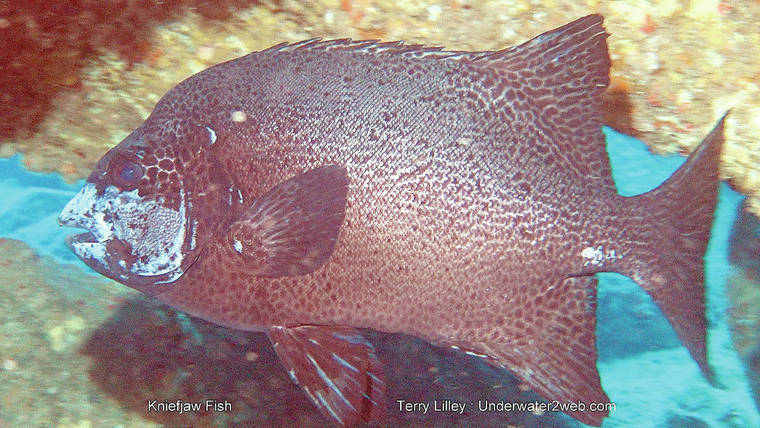500 years ago in Hawai‘i, before snorkel masks and fishing poles were invented, the Native Hawaiians stabbed fish with spears by hand or used several different types of fish traps. They were limited to fish they could catch in shallow water. Even big fish like the giant trevally or ulua came into shallow water to feed and were speared by the locals but certain fish that live in deep water were never seen by the Hawaiians at the time so they were never given a Hawaiian name.
500 years ago in Hawai‘i, before snorkel masks and fishing poles were invented, the Native Hawaiians stabbed fish with spears by hand or used several different types of fish traps. They were limited to fish they could catch in shallow water. Even big fish like the giant trevally or ulua came into shallow water to feed and were speared by the locals but certain fish that live in deep water were never seen by the Hawaiians at the time so they were never given a Hawaiian name.
The giant 150 pound and 30 inch long knife-jaw fish usually lives in the colder waters of Kaua‘i and O‘ahu but at depths of 100 feet to 1,000 feet deep. This huge grey colored fish has a tall rounded body but is only five to six inches thick. It has a huge set of teeth that are fused together and look like a parrot’s beak. It is sometimes called a beakfish or a broomfish because its large tail fin looks like a broom. The Knifejaw Fish is fairly slow moving and feeds on hard mollusks like scallops and barnacles that it can crush with its powerful jaws.
Even today fishermen in Hawaii rarely catch one of these fish because they won’t bite on the type of bait commonly used with a fishing pole but spearfishermen like myself will see one from time to time hiding in deep water caves. The Knifejaw fish is extremely good to eat and in Japan they catch them with deep water fishing trawlers and sell them for a lot of money to be served in the upscale restaurants.
I had been scuba diving in Hanalei Bay for over 10 on a regular basis before I ever saw one of these large strange looking fish because they usually live deeper than we can go while diving but in 2018 I saw my fish one at 40 feet deep. I didn’t even know what the fish was until I shot a video of it and sent that off to UH to get it identified. The big Knifejaw fish was eating scallops right off of an underwater cliff at Lumahai by placing its lower jaw into the open scallop then twisting its massive powerful body to flip the scallop shell off of the cliff. It then scraped the tender scallop inside out of the shell with its powerful scraping teeth. I was quite stunned watching the whole event!
Over the past three years the Knifejaw Fish has now come into shallow water to feed and many spearfishermen see them in Kauai and Oahu. At one time I saw eight of these big fish in one cave at 50 feet deep near Sharks Cove along the North Shore of Oahu where I finally got some good video and pictures of them.
Why are these deep water fish coming into shallow water for the first time in 1800 years here in Hawaii? Is their deep water food running out so they are looking for a new food source or are the many Navy submarines that are using sonar and electronics offshore scaring them into shallow water? At this time we really do not know but something is changing. All around the Pacific Ocean where submarine activity is common, deep water fish are showing up in shallow water or dead up on the beach so we may have to start studying this potential problem.
Knifejaw Fish are easy to spear for divers because they have this large flat body and are an easy target. The problem with eating the fish is it may contain the fish poison ciguatera. The toxin in ciguatera comes from the sea urchins the Knifejaw feeds on and the urchins get the natural poison from the seaweed they eat. In order to eat the fish without getting sick one can take a tiny bite of the flesh and wait for five to six hours to see if it gives you a mild stomach ache. If you do not have a negative reaction to eating a small piece of the fish then it is unlikely that the fish has ciguatera. A small amount of ciguatera which is a neurotoxin won’t harm you but eating a huge meal of a ciguatoxic fish could cause you to have a hospital stay for months!
You can see the Knifejaw Fish in action in my underwater educational movie The Worlds Guide To Hawaiian Reef Fish up on my web at www.underwater2web.com. Also on the web is my world wide marine life educational series we are doing for the schools and sustainable eco-tourism here in Hawaii.
•••
Terry Lilley is a marine biologist living in Hanalei, and co-founder of Reef Guardians Hawaii, a nonprofit on a mission to provide education and resources to protect the coral reef. To donate to Reef Guardians Hawaii go to www.reefguardianshawaii.org.

Subscribe today for unlimited access.
Already a subscriber?
Login
Not ready to subscribe?
Register for limited access.
If you have a print subscription but require digital access,
activate your account.




